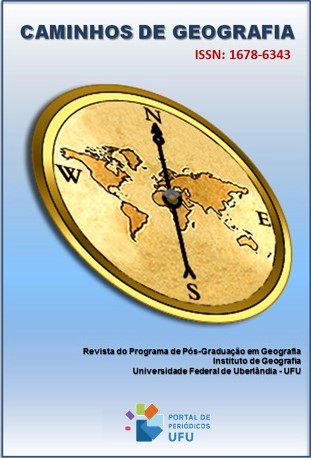COMPARTIMENTAÇÃO GEOMORFOLÓGICA DO EXOCARSTE DE NATIVIDADE E CHAPADA DA NATIVIDADE – TO
DOI:
https://doi.org/10.14393/RCG249161623Palavras-chave:
Compartimentação geomorfológica, Relevo cárstico, Natividade, Chapada da Natividade, TocantinsResumo
O sudeste do Tocantins caracteriza-se, dentre outros aspectos geográficos, pela presença de um carste bem desenvolvido, o que motivou a realização da compartimentação geomorfológica do relevo cárstico localizado nos municípios de Natividade e Chapada da Natividade. Neste sentido, este artigo objetivou tecer considerações sobre a influência dos fatores endógenos e exógenos na configuração da paisagem, enquanto eram definidas cada porção do relevo. Para tanto, com o auxílio das imagens dos satélites ALOS/Palsar, Sentinel 2A e da carta topográfica (SC.23-Y-C-IV), foram feitos mapas da rede de drenagem local, de altimetria, declividade, assim como a confecção de perfis topográficos e bloco diagrama, para melhor detalhamento do exocarste. In loco, o software Avenza Maps e os pontos espacializados no Google Earth Pro tornaram a navegação rápida e objetiva. A partir de então, dividiu-se a área em três compartimentos: Compartimento dos Planaltos Metassedimentares Não-Carbonáticos (PMNC), Compartimento dos Planaltos Carbonáticos (CPC) e Superfícies com Ocorrência de Dolinas (SCOD). O trabalho resultou ainda na elaboração de um mapa exploratório de fenômenos cársticos em escala de semidetalhe (1:50.000). O trabalho pode contribuir para a elaboração de políticas ambientais e servir de referência às novas pesquisas, auxiliando na produção de conhecimento mais detalhado do carste da região estudada.
Downloads
Downloads
Publicado
Edição
Seção
Licença
Copyright (c) 2023 Péricles Souza Lima, Fernando de Morais

Este trabalho está licenciado sob uma licença Creative Commons Attribution-NonCommercial-NoDerivatives 4.0 International License.
Autores que publicam nesta revista concordam com os seguintes termos: a) Autores mantém os direitos autorais e concedem à revista o direito de primeira publicação, com o trabalho licenciado sob a Creative Commons Atribuição-NãoComercial-SemDerivações 4.0 Internacional. b) Autores têm permissão e são estimulados a publicar e distribuir seu trabalho online (ex.: em repositórios institucionais ou na sua página pessoal), já que isso pode gerar alterações produtivas, bem como aumentar o impacto e a citação do trabalho publicado. c) Em virtude de aparecerem nesta revista de acesso público, os artigos são de uso gratuito, com atribuições próprias, em aplicações educacionais e não-comerciais.











